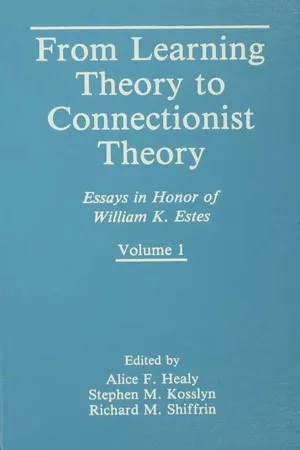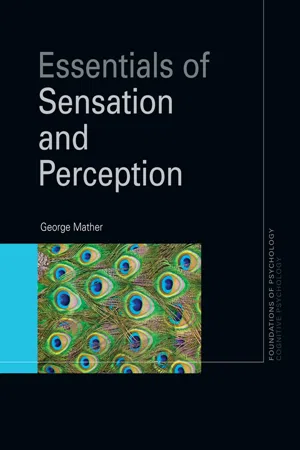Psychology
Ernst Weber
Ernst Weber was a German physician and psychologist known for his work in psychophysics. He is best known for Weber's Law, which describes the relationship between the magnitude of a physical stimulus and the perception of change in that stimulus. Weber's work laid the foundation for the study of sensory perception and the understanding of the human senses.
Written by Perlego with AI-assistance
Related key terms
3 Key excerpts on "Ernst Weber"
- eBook - ePub
From Learning Theory to Connectionist Theory
Essays in Honor of William K. Estes, Volume I; From Learning Processes to Cognitive Processes, Volume II
- Alice F. Healy, Stephen M. Kosslyn, Richard M. Shiffrin(Authors)
- 2013(Publication Date)
- Psychology Press(Publisher)
Perhaps the Psychological Continuum and the units of dispersion used to measure distances between stimuli presumed to lie on the continuum were unnecessary. Perhaps a great deal of psychophysical analysis could be replaced by an approach more in keeping with Stimulus Sampling Theory and the urn models of early quantum mechanics. My first theoretical goal was to provide a new foundation for Weber’s Law and Weber’s Constant that bypassed the Psychological Continuum. The result proved to be quite satisfactory, generating Weber’s Law, Weber’s Constant, and Fechner’s Law (Link, 1990, 1992) by way of a realizable physical process.A startling discovery followed: The new theory required only a single parameter to predict the 49 paired comparison proportions from Guilford’s classic experiment. That single parameter proved to be Weber’s Constant. By knowing the value of Weber’s Constant for lifted weights the response proportions were predictable in advance of the experiment. The general features of this new theory, Wave Theory, are introduced in the following. A more extensive treatment is available elsewhere (Link, 1992).Stimulus Representation
Judgments about stimuli are comparative. Comparisons are often made between stimuli presented to the external senses such as the heaviness of two weights, the brightnesses of two lights, the tastes of two vegetables. Such stimuli are the generators of quantum pulses of electrical energy. The pulses are created by sensory transceivers located on or near the body’s surface, or embedded in a region of body tissue.The number of pulses generated by a stimulus in a unit of time follows a particular probability distribution. That distribution is known as the Poisson distribution in honor of the great French mathematician S. D. Poisson who, in 1837, derived the form of the probability distribution from quite primitive assumptions. Later mathematical research showed that the Poisson distribution arises quite frequently in nature because it derives from a much broader set of possibilities than Poisson suspected (Billingsley, 1979; Chow & Teicher, 1988). Most important, the variability in the Poisson distribution is an inherent part of the mechanism that generates pulses of energy. Variability is, part and parcel, a consequence of stimulation, not an error that is added to a pure stimulus. - eBook - ePub
Sensation and Judgment
Complementarity Theory of Psychophysics
- John C. Baird(Author)
- 2014(Publication Date)
- Psychology Press(Publisher)
After reviewing the empirical evidence on local psychophysics, an explanation of stimulus discrimination consistent with the traditional Fechnerian view, but built on the assumptions of the Sensory Aggregate Model, is proposed. The source of internal variability is ascribed to the firing rates of neurons comprising the ensemble of excitation associated with each stimulus. The standard deviation of this firing rate distribution is the sensory correlate of the JND obtained psychophysically.WEBER’S LAWThe oldest way to determine perceptual sensitivity is to ask what minimum stimulus change is necessary for a subject to notice a difference. Using the approach introduced by Weber (1846) and Fechner (1860/1966), it was proposed in the last century that the JND is a linear function of the intensity at which it is determined. Weber’s law describes this empirical relation, where ΔS is the JND, S is the standard, and k is the Weber fraction.The value of k reflects the discriminability of closely spaced stimuli: the higher k, the lower the sensitivity. Table 4.1 lists typical Weber fractions for a variety of stimulus attributes. The values range from 0.02 for electric shock to 0.24 for odor. (These values are taken from empirical studies cited in Baird, 1970a, and Baird & Noma, 1978).TABLE 4.1Representative Weber Fractions (after Baird & Noma, 1978)
Figure 4.1AttributeWeber FractionΔS/SFinger span 0.02 Saturation (red) 0.02 Electrical (skin) 0.03 Position of point (visual) 0.03 Length of lines (visual) 0.04 Area (visual) 0.06 Heaviness 0.07 Brightness 0.08 Loudness (1000 Hz, energy units) 0.10 Taste (salt) 0.14 Taste (sweet) 0.17 Skin vibration (100 Hz–1100 Hz) 0.20 Smell 0.24 - eBook - ePub
- George Mather(Author)
- 2014(Publication Date)
- Routledge(Publisher)
Starting from the initial detection of a very weak stimulus (a tiny weight, a dim light), he reasoned that if you were to count up just noticeable differences in stimulus intensity you would actually be counting up equal sensory intervals along a subjective, psychological scale of perceived magnitude. So a small increment to a light weight (or a dim light, or a quiet sound) would produce the same increase in perceived weightiness (or brightness or loudness) as a large increment to a very heavy weight (or a bright light, or a loud sound). This insight became known as Fechner’s Law, and it had a fundamental impact on psychology and physiology. It offered the beginnings of an answer to an age-old philosophical problem, the relation between mind and body, the mental (psychical) world and the physical world. Fechner had discovered a simple mathematical link between the laws of the mind and the laws of physics; a psychophysical law. He went on to work out and formalize a set of psychophysical methods for measuring JNDs. Variants of these methods are still in use today to measure both JNDs and other more complex psychophysical phenomena, and they still yield insights about sensory function that could not be obtained by any other means. Key Term Fechner’s Law. A principle describing the relationship between sensation magnitude and stimulus magnitude. Key Concept Psychophysical threshold In Elemente der Psychophysik, published in 1860, Fechner described several experimental methods to measure the relation between sensory stimuli and perceptual responses, and these methods have been refined over the years to improve their reliability. As an example, consider a simple ‘yes/no’ psychophysical method to measure the relation between stimulus intensity and detection. The participant is presented with a stimulus, and asked to respond ‘yes’ or ‘no’ to indicate whether they can detect it or not
Learn about this page
Index pages curate the most relevant extracts from our library of academic textbooks. They’ve been created using an in-house natural language model (NLM), each adding context and meaning to key research topics.


